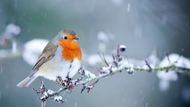A Guide to Common UK Garden Birds
15th Jan 2025
The gardens of the United Kingdom are home to a wonderful variety of birds, each bringing its unique beauty, song, and charm to outdoor spaces. Whether you're a seasoned birdwatcher or a curious beginner, getting to know the common garden birds can deepen your appreciation for the wildlife just outside your door.
Here’s a guide to some of the most common UK garden birds, how to identify them, and tips for attracting them to your garden.
1. Robin (Erithacus rubecula)
Appearance:
- Small bird with a bright orange-red breast and face.
- Brown back, wings, and tail, with a white belly.
Song:
A soft, melodious warble often heard year-round, even during winter.
Behaviour:
Robins are friendly and curious, often seen hopping close to gardeners as they dig up the soil in search of worms.
How to Attract Them:
- Provide mealworms, suet, or soft fruits.
- Leave undisturbed areas for nesting, such as hedges or climbing plants.
2. Blue Tit (Cyanistes caeruleus)
Appearance:
- Bright blue cap and wings, yellow belly, and green back.
- A small black stripe across its white face.
Song:
A series of high-pitched, cheerful chirps and trills.
Behaviour:
Acrobatic and lively, Blue Tits are often seen hanging upside down on feeders or searching tree branches for insects.
How to Attract Them:
- Offer sunflower seeds, peanuts (unsalted), or fat balls.
- Install nest boxes with small entrance holes.
3. Blackbird (Turdus merula)
Appearance:
- Males: Glossy black feathers with a bright yellow beak and eye-ring.
- Females: Brown feathers with a speckled breast.
Song:
A rich, flute-like melody, especially prominent at dawn and dusk.
Behaviour:
Blackbirds are ground feeders, often seen searching for worms and insects in lawns.
How to Attract Them:
- Provide fruits like apples, raisins, or berries.
- Leave leaf piles or compost heaps where they can forage.
4. House Sparrow (Passer domesticus)
Appearance:
- Males: Brown and black streaked back, grey cap, and a black bib.
- Females: Plainer brown with a streaked back and buff underside.
Song:
A repetitive, chirping call that is sociable and lively.
Behaviour:
Often found in noisy, chattering groups, house sparrows are highly sociable and love dense hedges and shrubs.
How to Attract Them:
- Provide seeds, grains, and suet in accessible feeders.
- Offer dense bushes or shrubs for roosting and nesting.
5. Starling (Sturnus vulgaris)
Appearance:
- Dark feathers with an iridescent sheen of green and purple, speckled with white.
- In winter, their plumage is more heavily speckled.
Song:
A varied mix of whistles, clicks, and mimicry of other birds or sounds.
Behaviour:
Starlings are social and often gather in large, noisy flocks, especially during the famous murmuration displays at dusk.
How to Attract Them:
- Provide suet, mealworms, or kitchen scraps.
- Offer open-fronted nest boxes.
6. Goldfinch (Carduelis carduelis)
Appearance:
- Bright red face with black and white markings.
- Golden-yellow wing bars and a brown back.
Song:
A high-pitched, twittering melody.
Behaviour:
Goldfinches are graceful and sociable, often seen in small flocks feeding on seed heads or visiting feeders.
How to Attract Them:
- Offer nyjer seeds or sunflower hearts in specialised feeders.
- Plant teasels, thistles, and dandelions for natural feeding.
7. Great Tit (Parus major)
Appearance:
- Bold black head and neck with white cheeks.
- Yellow belly with a black central stripe and greenish back.
Song:
A two-note call often described as "teacher-teacher."
Behaviour:
Great Tits are larger than Blue Tits and can be territorial around feeders. They’re also inquisitive and adaptable.
How to Attract Them:
- Provide peanuts, sunflower seeds, and suet.
- Install a nest box with a slightly larger hole than those for Blue Tits.
Tips for Attracting Garden Birds
- Provide Food: Use a variety of feeders to cater to different species—hanging feeders for tits and finches, ground feeders for blackbirds and robins.
- Offer Fresh Water: A birdbath or shallow dish of clean water is essential for drinking and bathing.
- Create Shelter: Plant dense shrubs, hedges, or climbing plants where birds can nest and hide.
- Avoid Pesticides: These can harm insects that birds rely on for food.
- Be Patient: It may take time for birds to discover your garden, so keep providing food and maintaining your space.
By creating a bird-friendly garden, you not only enjoy the beauty and song of these delightful creatures but also contribute to the conservation of their populations. Whether you’re watching a robin hop along the ground or marvelling at a murmuration of starlings, the presence of birds can bring endless joy to your outdoor space.
Which birds have you spotted in your garden recently? Share your experiences in the comments below!






